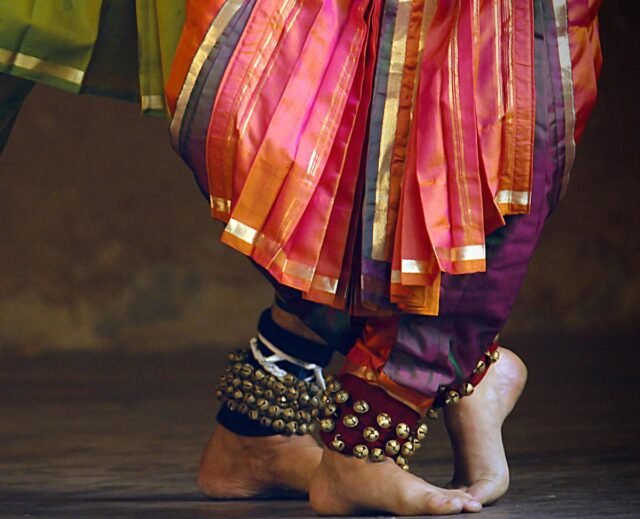The strength of Indian knowledge systems—what we call the Bhāratīya jñāna paramparā —lies in their ability to evolve and find new meaning across time and place. While not grounded in metaphysical thought, these traditions were never static. They offered flexible ways of understanding the body, mind, and cosmos—ways that could be expressed, practiced, and passed on. The well-known Vedantic image of a spider spinning its web helps us imagine this relationship: the eternal, indivisible consciousness weaving creation while remaining in it. Scholar Kapila Vatsyayan has described this as the integrative nature of Indian aesthetics, in which philosophy, ritual, and performance meet a living knowledge of embodiment.
In this context, art and ritual are not separate from life, but essential tools for self-discovery. Through gesture, movement and storytelling, dancers give form to abstract ideas and bring philosophy to life in a lived experience. Each unit of movement in Indian dance has a symbolic meaning, connecting the small world of the individual with the vast order of the universe. Here, the meeting of Bhavas (emotions) and Rasas (aesthetic experiences) transcends performance. This creates a language in which codified gestures transcend the inner life of the dancer with the collective response of the audience.
The main text that codifies how movement and gesture function in Indian classical performance is the Nandikesvara Abhinaya Darpanam (A Basic Sanskrit Text on Indian Classical Dance, Focusing on Angika Abhinaya, Which Acts as a Guide for the Dancer). The first known printed edition was prepared by Kavi Lingamaggunta matrbhutayya in Telugu (published in 1851). In 1887, Madabusi Tiruvenkatacharyulu of Needamangalam (NIDA) published a prose translation in Telugu. The text reached an international audience through its first English translation, The Mirror of Gesture: Being Nandikeshvara Abhinaya Darpanam, published in 1917 by Ananda Coomaraswamy and Gopala Krishnayya Duggirala. A few decades later, Manmohan Ghosh brought out another influential bilingual edition in 1934, revised in 1957, which presented the Sanskrit and English texts side by side.
Subsequent translations further expanded the reach of the work in India. Based on Manmohan’s revised edition, Vacaspati Gairola translated the text into Hindi under the title Bharatiya Natya Parampara (1967). Later, Professor P.S.R. Appa Rao attempted to reconcile the differences between Nida’s and Manmohan’s editions by publishing Abhinaya Darpanam of Nandikesvara first in Telugu (1987) and then in English (1997). Together, these scholarly efforts have ensured that Abhinaya Darpanam remains accessible across linguistic and cultural boundaries, securing its place as a cornerstone of Indian performance traditions. However, outside of these publications, the text has lived on most in practice halls, classrooms, and in the memories of the dancers themselves.
Galvenais teksts, kas kodificē to, kā kustība un žestu funkcija Indijas klasiskajā veiktspējā ir Nandikesvara Abhinaya Darpanam.
| Fotoattēls: Hindu arhīvs
Tas bija Rukmini Devi, kurš vispirms uzstāja uz ieviešanu Abhinaya Darpanam Mācību programmā Kalakshetrā. Turpmāk tā pedagoģisko mantojumu ir pārvadājusi, it īpaši Natyacharyas Shanta un viceprezidents Dhananjayan, nodrošinot tā pastāvīgo pārraidi uz jaunām dejotāju paaudzēm.
2008. gadā es izmantoju šo mantojumu, lai publicētu rokasgrāmatu ar nosaukumu Ziņojums kustībāskas īpaši izveidots starptautiskiem studentiem. Vēlāk es nācu klajā ar visaptverošāku izdevumu – Abhinaya darpaṇam: ilustrēts tulkojums, kas tagad ir tā ceturtajā izdevumā.
Pedagoģiskā tvērums
Ievada līmenī, Abhinaya Darpanam piedāvā progresīvu ietvaru žesta izpratnei (mudra), kustību vienības (Adavu, Chari, Mandala) un to izpilde, izmantojot kinestētisko izpratni. Dejotāji kultivē kustības iekšēju vizualizāciju, uzlabojot propriocepciju un muskuļu iesaistīšanos, izmantojot intuitīvus attēlus.
Shanta un VP Dhananjayan nodrošināja Abhinaya DarpanamTurpinātais pārraide jaunām dejotāju paaudzēm, izmantojot virkni darbnīcu. | Fotoattēls: Hindu arhīvs
Vidējā un progresējošā līmenī teksts aicina izpētīt – kultūras, rituālu un simboliskas žestu nozīmes dažādās indikācijas tradīcijās. Dialektika starp objektīvo formu un subjektīvo izteiksmi. Ķermeņa prakse kā identitātes veidošanās, sarunu un transcendences vietas. Kā kustību vārdnīcas klasiskajā dejā kodē ekoloģisko gudrību, izmantojot simboliskas atsauces uz dabiskajiem elementiem, sākot no ārstniecības augiem līdz ūdens dzīvei – apstiprinot pasaules uzskatu, kas koncentrē savstarpējo atkarību un svēto ekoloģiju.
Šajā paplašinātajā sistēmā, Abhinaya Darpanam var pielāgot, lai iesaistītu šādas dimensijas: estētiskā izpratne (izjust ķermeni kā pārdomas un pārveidošanas vietu, izmantojot fokusētu kustību), kognitīvā izpratne (izpratne par deju kā precīzu un spēcīgu neverbālo valodu), psiholoģisko apziņu (izmantojiet iemiesotu praksi un izdalīt emocionālos stāvokļus, piemēram, apdraudēšanu, stresu un agresiju), kultūras izpratnes veidošanu (veidojot to, kas tiek parādīta, mythomey, mythespression), kultūras izpratnes veidošana (veidošana. social hierarchies, biomechanics (studying joint articulation, muscle control and postural mechanics to support injury prevention and optimal movement efficiency) and Natya-yoga (integrating ethical principles of yoga into artistic practice and community engagement) — this aspect foregrounds the dancer as both Sadhaka un pilsonis, iemiesojot vērtības, kas pārsniedz estētiku dzīvā ētikā.
Nozīme
Among the nearly 29 known Sanskrit texts on Natya, Abhinaya Darpanam stands out for its granular focus on movement, gesture, and expressive technique. For the contemporary dancer—approached through the Desi Margi Tradition, Bharatanatyam, Kuchipudi, Manipuri, Mohiniyattam Kathakali, or Chhāu—it is not just a manual, but a mirror: reflecting the dancer’s inner landscape, shaping the body into a vessel of empathy, a holder of memory, and a self-knower. Faithful to its origins, yet resonant in the present, it speaks to our ongoing search for meaning, belonging, and transformation.
Published – September 02, 2025 05:55 PM IST













